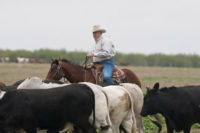Tough Enough!
by Richard Mitchell
Bone-in packaging not only is strong enough to repel punctures, but attractive enough to appeal to retailers and consumers.
Case-ready meat and poultry’s increasingly prevalent presence in retail aisles is having a catalyzing effect on packaging. In response to merchant demands for aesthetically appealing products that will grab the attention of consumers, packages are being designed with greater clarity and striking graphics. And with bone-in products becoming more popular, manufacturers are adding elements for greater strength and resiliency to withstand stresses from shipping and handling and to prevent punctures.
“Bone-in packaging on the store shelf has to be stronger and look much nicer than the typical packages of the past.” says Mike Hiteshaw, global marketing manager of perishable food packaging for DuPont Packaging, a Wilmington, DE-based resin manufacture.
DuPont formulations include adhesives that are designed to bond together multiple layers of dissimilar films for enhanced functionality without diminishing clarity, he says. They include sealants that come in contact with the meat, and barriers that keep oxygen and moisture from entering and exiting bags. Nylons also are incorporated into outer layers for added durability
Recent enhancements are enabling the adhesives to seal faster and at lower temperatures, and allowing film clarity to be maintained after the sealing and shrinking procedures. Such processes are causing more processors to eschew the traditional patch bags in favor of packaging that contains stronger films throughout the design, Hiteshaw says.
“Retailers are demanding more merchandisable structures, so manufacturers can’t necessarily produce packages with a big patch, an opaque patch, or a cloudy structure,” he notes. “It has been a challenge because most of the materials that were good from a puncture resistant standpoint weren’t necessarily clear.”
Case-ready solution
Indeed, lucidity is becoming increasingly important as more packers — who once shipped large primals to butchers in vacuum bags for in-store cutting — now are producing a variety of cuts in bags that go directly to store displays, says Dave McCaffrey, vice president and general manager of Totowa, NJ-based Inovpack Vector Inc.
Inovpack Vector is supporting case-ready, bone-in meat and poultry with its Vector 80, and lighter weight Vector 30, patchless, high-barrier shrink bags that contain three layers of nylon-based film for added protection.
“Processors want bags that are strong but also have more eye appeal so they are putting greater value on clarity and products with attractive print,” he notes.
Demand for sturdy bone-in packaging also is coming from foodservice operators, hotels, and consumers who want to reheat pre-cooked items without removing the food from its original bags. Such dishes can be prepared faster, often marinate better and are more tender when reheated, McCaffrey says.
He adds that potent cook-in bags that users can boil or roast bone-in meat and poultry in also are becoming more popular as processors and merchants take steps to minimize the handling of meat to reduce the threat of contamination.
To more effectively shield products, manufacturers also are designing packages to protect specific types of cuts. Oshkosh, WI-based Curwood Inc., for instance, is offering a variety of bone-in shrink bags as part of its ArmorX ABP line:
ABP 35 is intended for bone-in pork spareribs, St. Louis style spareribs; back ribs, bone-in loins, picnics, butts, and shanks.
ABP 55 is designed for smoked turkeys, bone-in hams, smoked picnics, and smoked butts.
ABP 65 is formulated for beef back ribs, short ribs, short loin, lamb rack, and lamb chops.
The bags contain high-oxygen and moisture barriers that are designed to maximize shelf life, and have high-shrink multilayer coextrusions laminated together for greater strength.
It is essential that case-ready, bone-in products have tight shrink to be visually appealing and help minimize the threat of juices seeping out of the beef, says Bill Goerich, Curwood senior marketing manager.
“Case-ready bags also need to be puncture resistant,” he notes. “That is especially important for products that are shipped to merchant sites that don’t have in-store butchers on staff, as those retailers are not prepared to repackage leakers.”
Reducing damaged packages
Restoring damaged packages also can be expensive. Frank Kitchell, marketing manager, fresh meat, for Chicago-based Alcan Packaging, says it can cost between 50 cents and $1 to replace a bag in addition to the labor charge for repacking the product.
Alcan is marketing three bone-in products under its ClearShield branded film. The B-3200, which is intended to hold beef and lamb, and the B-3300, which is formulated for pork and larger cuts such as a full loin, are constructed with heavier materials to contain the larger bones common to wholesale shipments.
Alcan’s B-3350 retail product has a tighter shrink to control the tenderizing solutions that are used for ham, spareribs, baby-back ribs, and other items. The B-3350 also is designed to hold dry meats.
Each bag has a different grade of sealant that is formulated to withstand the stresses from specific types of fat, Kitchell says. The packages contain a blend of puncture-resistant polymers and are intended to support disparate types of bones.
Alcan also is focusing on providing bone-in bags with added lucidity so consumers can get a more explicit view of meat and poultry prior to selecting products.
Clearer bags also enable butchers to better assess the marbling and the overall condition of meats before opening packages. The merchants then can more easily return products to processors if they are dissatisfied with the coloring.
Such clarity also allows butchers to more accurately gauge the type of cut in each bag. By then refrigerating the unopened packages, they can insure that a wide variety of meats are kept in stock.
“Meat and poultry have a shelf life of about three days once a butcher cuts the bag open,” Kitchell notes. “But products can last thirty to forty-five days when bags remained sealed and properly refrigerated.”
The bone-in packaging being marketed by Alcan and other manufacturers is formulated with puncture-resistance materials across the total perimeter of the product. The designs exclude such traditional components as patches and bone wraps. By strengthening the entire package, packers can avoid the labor-intensive task of orientating the bone in each cut of meat to a patch, Kitchell adds.
Yet, patch bags are also being upgraded to more effectively support bone-in meats and poultry. Duncan, SC-based Cryovac/Sealed Air, for instance, a developer of patches and films, is tailoring its products to protect specific cuts.
A variety of designs are needed because bone locations vary from cut to cut, and the products retain different amounts of moisture, says Jim Mize, Cryovac/Sealed Air director of marketing, fresh red meat.
“Sealability capabilities can be critical, especially for bags that need to hold moisture-enhanced pork products,” he notes. “The ability to withstand abuse is more of an issue for beef packaging because those cuts tend to be bigger and heavier. But in each instance, it is important not to over-engineer the bags. Attaching extra material can diminish the packages’ clarity.”
Better presentation
Cryovac/Sealed Air’s TPG patch bag line includes Max Patch, which has tight shrink for better case-ready presentation, Mize says. The patches are clear so consumers can gage the status of meat, and also read the nutritional information, cooking instructions and other print that is situated beneath the patch. Covering the print shields the ink from the stresses that occur during shipping and handling.
Other TPG designs include the Rotated Patch, which is intended for picnics that requires bone guards on the sides; and the Wide Patch, which provides coverage across the entire product and is best suited for meat and poultry being transported to the butcher shop for cutting.
“Clarity is not as important for wholesale packaging so you tend not to worry if a product going into the back room has too much patch,” he notes. “But the consumer is more attracted to retail case products that are as tight and snug as possible without much material overhang.”
Mize adds that the bags are being engineered to make it simpler for processors to align bones with the patches, and that users having difficulty matching the elements are likely using the wrong type of bag for their particular cut of meat. He says he expects market interest in bone-in packaging to become stronger as the popularity of case-ready products increases.
“Retailers over the long term will want to make their meat and poultry products more visually appealing, so the demands on packaging will grow” he notes.
Yet, even with many manufacturers enhancing their bone-in packaging, some processors say additional improvements still are needed before the products meet all of their requirements.
“We see small steps being taken, but large steps are needed to effectively sell case-ready bone-in products in the vacuum-packed, bone-guard bags,” says Joe Weber, vice president of fresh pork for Smithfield, VA-based Smithfield Packing Co., a unit of Smithfield Foods. “There still is room for refinement in the appearance, clarity, and general presentation of the bag. That remains one of the weakest links in case ready.”
He notes, however, that recent packaging upgrades, such as tighter shrink, are effectively retarding bacteria growth and helping to expand the shelf life of products.
“The demand for bone-in products will not go away, and the packaging will continue to evolve,” Mize adds. NP
Technology sources contributing to this article include:
Alcan Packaging, phone (773) 399-8513, fax (773) 399-3330, e-mail lisa.apolinski@alcan.com, or visit www.alcanpackaging.com
Cryovac/Sealed Air Corp., phone (864) 433-2000, or (800) 845-3456, fax (864) 433-2134, e-mail: mkt@sealedair.com, or visit www.cryovac.com
Curwood Inc., phone (920) 303-7300 or (800) 544-4672, fax (920) 303-7227, e-mail: curwood@bemis.com, or visit www.curwood.com
DuPont Packaging, phone (302) 774-1000 or (800) 628-6208, fax (302) 999-4399, e-mail packaging@dupont.com, or visit www.dupont.com/packaging
Inovpack Vector Inc., phone (630) 434-0040 or (800) 435-9100, fax(630) 434-9100, e-mail: inovpackvector@aol.com, or visit www.inovpackvector.com
Richard Mitchell is a freelance writer in the Chicago area.

.jpg?height=200&t=1659636668&width=200)
